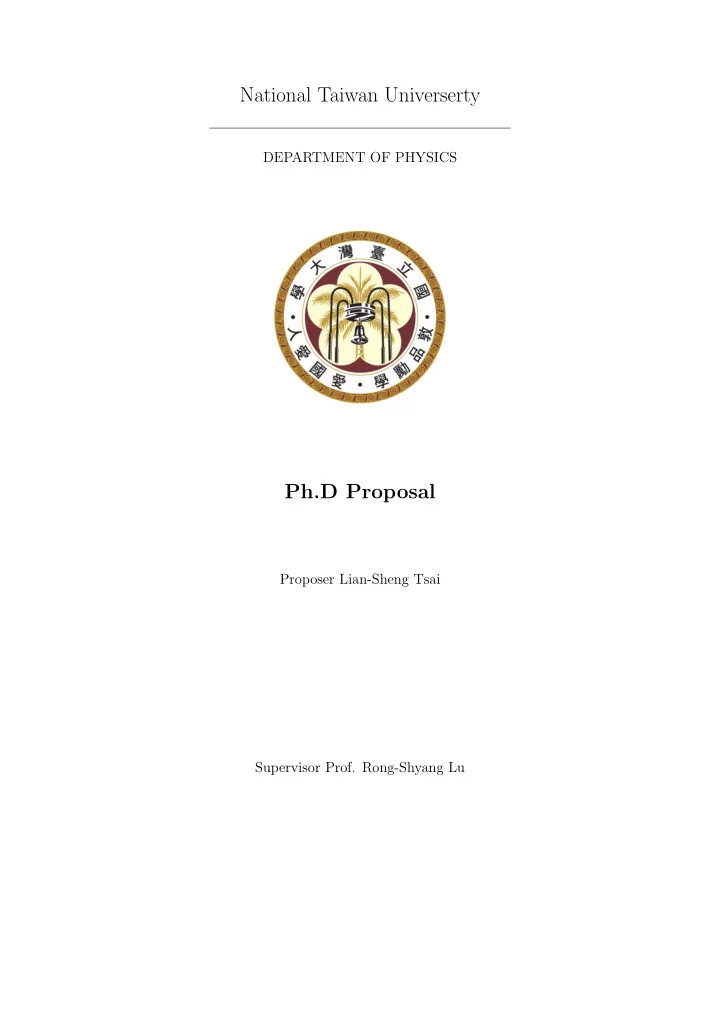

National Taiwan Universerty DEPARTMENT OF PHYSICS Ph.D Proposal Proposer Lian-Sheng Tsai Supervisor Prof. Rong-Shyang Lu
1 INTRODUCTION 1 Introduction ❼ particle physics ❼ standard model ❼ QCD ❼ colour charge ❼ colour confinement (*) ❼ parton distribution function. ❼ broken x ❼ deep inelastic scattering ❼ gamma+jet as a probe to PDF and feynman diagram ❼ (No predition of PDF in QCD @ abstract) To explain the phenomenon of elementary particles with mathematical language, physicists creates numerous models and tries to have a coverage on all particle behaviours. Being an essential key to understand the laws of nature, particle physics focuses on the elementary particles and the forces, which means the fundamental constitute of the Universe and the interaction around them. Our current un- derstanding is presented on the Standard Model (SM) in particle physics, which provides a framework to interpret how elementary particles interacts with each other by the forces. The Standard Model successfully describes experimental data until now. Figure 1: Elementary Particles in Standard Model. Accroading to spin, fundamental particles are categorized as two class: fermion and boson. Fermion constitutes matter in the world. And boson delivers the forces between fermions. Figure comes from [1] Accroading to spin, the standard model groups the elementary particles into two species 1. Fun- damental spin-half particles, named as fermion, follow that follows Fermi-Dirac statistics [2]. Obeying the Pauli exclusion principle, fermion includes all quarks and leptons, as well as composite particles such as all baryons and atoms. In addition to fermion, fundamental spin-integer particles are recognized as boson, which obeys Bose-Einstein statistics [2]. The four gauge boson of the Standard Model are photons, gluons, W bosons and Z bosons. Each of them delivers electromagnetic force, strong force and weak force separately. Graviton and recently discovered Higgs boson are also belonging to bosons. In the Standard Model, quantum chromodynamics (QCD) is the theory concerntrates on strong interaction between the quarks and gluons. Composite hadrons such as proton, neutron and kaon are 1
4 HIGH GRANULARITY CALORIMETER classified by different valence quark constituents under this framework. To mathematically describe the mechanism, QCD follows quantum field theory (QFT), which connects each kind of interaction and a gauge field with respect to gauge invariant corresponding Lie group transformation according to Yang- Mills theory. The underlying symmetry associated with QCD is invariance under SU(3) local phase T a = T a of the SU(3) transformations. The phase transformation is performed by the eight generators ˆ symmetry group and the corresponding function α a ( x ) of the space-time coordinate x . ψ ( x ) → ψ ′ ( x ) = exp [ ig S α ( x ) · ˆ T ] ψ ( x ) (1) Under the language of the group theory, each generator in the SU(3) local gauge symmetry corresponds to a massless gluon. SU(3) local gauge symmetry gives three conserved ”colour” charges (Where charge is a simuliar map from quantum electrodynamics in U(1)). Only particles which have non-zero colour charge couple to gluons. Being a colour neutral states, the leptons are not able to feel the strong force. But for quarks, which carry colour charge, exist in three orthogonal colour states. Unlike leptons and hadrons, we are not able to directly detect free quark, which would be observed as fractionally charged particles. Colour confinement is the hypothesis to illustrate the non-observation of free quark. This hypothesis states that all coloured objects are extremely confined to colour singlet states by strong force. Such that the only condition to propragate a free particle is the particle carries no colour charge. The origin of colour confinement is believed from the gluon-gluon self-interaction due to the theoritally allowing that gluons carry colour charge. 2 Apparatus and Analysis Tools ❼ LHC ❼ CMS detector ❼ object reconstruction – photon – jet ❼ Simulation 3 Analysis Stretagy ❼ object recognization – photon identification – jet identification ❼ multivariable analysis ❼ fitting procedure ❼ separate bin analysis ❼ systematics control 4 High Granularity Calorimeter ❼ introduction to HGCal ❼ HGCal @ NTU ❼ current status 2
5 FUTURE 5 Future ❼ HGCal will be installed at 20XX, increasing high eta region resolution. ❼ exotic quark observation from increasing integrated luminosity. 3
REFERENCES REFERENCES References [1] Cush MissMJ. Standard Model of Elementary Particles . 2019. url : https://upload.wikimedia. org/wikipedia/commons/thumb/0/00/Standard_Model_of_Elementary_Particles.svg/627px- Standard_Model_of_Elementary_Particles.svg.png (visited on 08/13/2020) (cit. on p. 1). [2] Richard M. Weiner. “Spin-statistics-quantum number connection and supersymmetry”. In: Phys. Rev. D 87.5 (2013), p. 055003. doi : 10.1103/PhysRevD.87.055003 . arXiv: 1302.0969 [hep-ph] (cit. on p. 1). 4
Recommend
More recommend